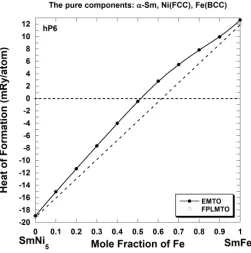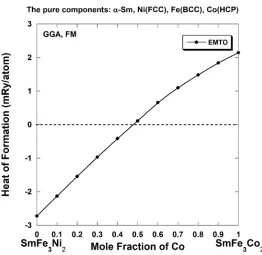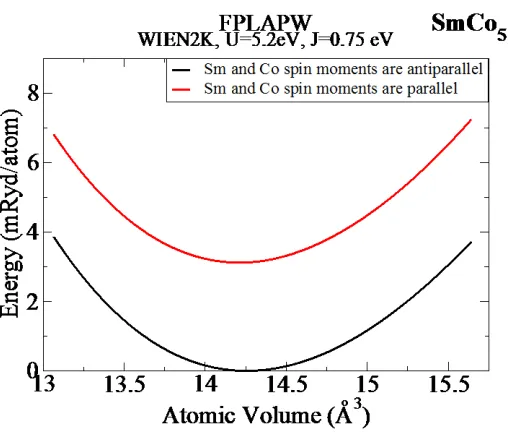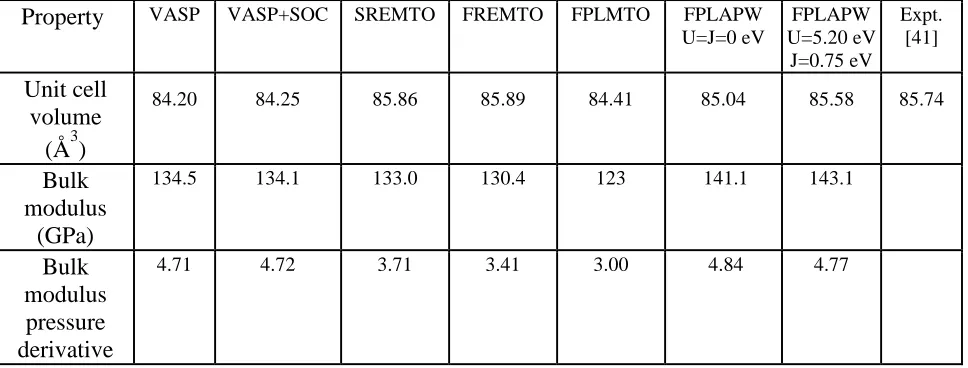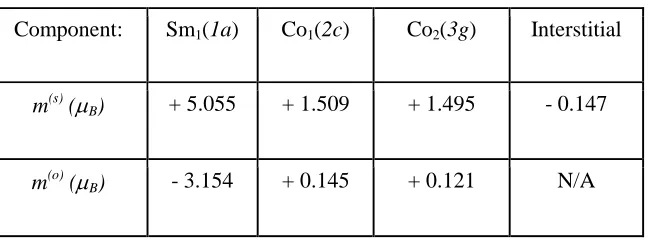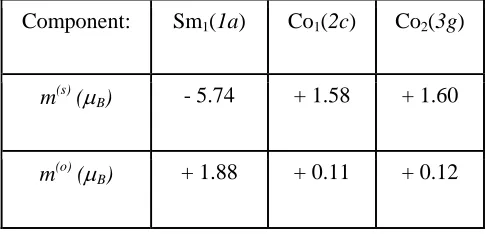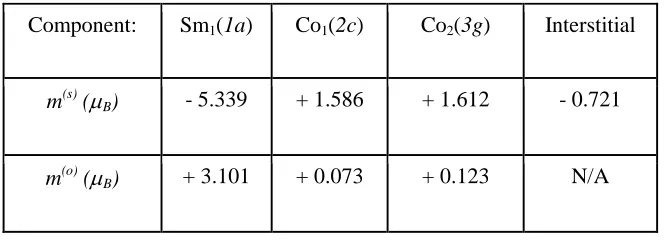Ames Laboratory Accepted Manuscripts Ames Laboratory
6-23-2018
Thermodynamics of SmCo5 compound doped
with Fe and Ni: An ab initio study
A. Landa
Lawrence Livermore National Laboratory
P. Söderlind
Lawrence Livermore National Laboratory
D. Parker
Oak Ridge National Laboratory
D. Åberg
Lawrence Livermore National Laboratory
V. Lordi
Lawrence Livermore National Laboratory
See next page for additional authors
Follow this and additional works at:https://lib.dr.iastate.edu/ameslab_manuscripts Part of theMetallurgy Commons
This Article is brought to you for free and open access by the Ames Laboratory at Iowa State University Digital Repository. It has been accepted for inclusion in Ames Laboratory Accepted Manuscripts by an authorized administrator of Iowa State University Digital Repository. For more information, please contactdigirep@iastate.edu.
Recommended Citation
Landa, A.; Söderlind, P.; Parker, D.; Åberg, D.; Lordi, V.; Perron, A.; Turchi, P.E.A.; Chouhan, R. K.; Paudyal, Durga; and Lograsso, Thomas A., "Thermodynamics of SmCo5 compound doped with Fe and Ni: An ab initio study" (2018).Ames Laboratory Accepted Manuscripts. 388.
Thermodynamics of SmCo5 compound doped with Fe and Ni: An ab
initio study
Abstract
SmCo5 permanent magnets exhibit enormous uniaxial magnetocrystalline anisotropy energy and have a high Curie temperature. However, their low energy product is a significant deficiency. To increase the energy product in SmCo5, we propose substituting cobalt with iron, that has a much larger magnetic moment, in a SmCoNiFe3 magnet where nickel is used as a thermodynamic stabilizer.
Keywords
Permanent magnets, Rare earth alloys and compounds, Anisotropy, Magnetization, Enthalpy, Computer simulations
Disciplines
Materials Science and Engineering | Metallurgy
Authors
A. Landa, P. Söderlind, D. Parker, D. Åberg, V. Lordi, A. Perron, P.E.A. Turchi, R. K. Chouhan, Durga Paudyal, and Thomas A. Lograsso
Thermodynamics of the SmCo5 compound doped with Fe and Ni: an ab initio study
A. Landa1, P. Söderlind1, D. Parker2, D. Åberg1, V. Lordi1, A. Perron1, P. E. A. Turchi1,
R. K. Chouhan3, D. Paudyal3, and T. A. Lograsso3,4
1
Lawrence Livermore National Laboratory, Livermore, CA, 94551, USA
2
Oak Ridge National Laboratory, Oak Ridge, TN, 37831, USA
3
Ames Laboratory, Ames, IA, 50011, USA 4
Department of Materials Science and Engineering, Iowa State University,
Ames, IA, 50011, USA
Abstract
SmCo5 permanent magnets exhibit enormous uniaxial magnetocrystalline anisotropy
energy and have a high Curie temperature. However, a low energy product presents a significant
drawback in the performance of SmCo5 permanent magnets. In order to increase the energy
product in SmCo5, we propose substituting fixed amount of cobalt with iron in a new magnet,
SmFe3CoNi, where inclusion of nickel metal makes this magnet thermodynamically stable. We
further discuss some basic theoretical magnetic properties of the SmCo5 compound.
1. Introduction
Three basic material parameters determine the intrinsic properties of hard magnetic
materials: (i) spontaneous (saturation) magnetization, Ms, (ii) Curie temperature, Tc, and (iii)
magnetocrystalline anisotropy energy (MAE), K1 [1]. These three parameters all need to be large
for the permanent magnet to be technologically suitable: Tc~ ≥ 550 K, Ms~ ≥ 1 MA/m, K1~ ≥ 4
MJ/m3. The desired values of these properties can be achieved by combining transition-metal
(TM) with rare-earth-metal (RE) atoms in various intermetallic compounds, where the RE atoms
induce a large magnetic anisotropy while the TM atoms provide a large magnetization and high
Curie temperature [1, 2].
SmCo5 (in the hexagonal CaCu5-type structure) magnets exhibit enormous uniaxial MAE
of K1 ~ 17.2 MJ/m3, substantially higher than that of Nd2Fe14B (Neomax) magnets (K1 ~ 4.9
MJ/m3), and have almost twice the Curie temperature (Tc ~ 1020 K) compared to Neomax (Tc ~
588 K) [3, 4]. However, Nd2Fe14B currently dominates the world market for permanent magnets
product (BH)max of 512 kJ/m3, more than twice as high as the energy product of SmCo5 magnets,
(BH)max of 231 kJ/m3 [3, 4]. Although SmCo5 magnets are more suitable for high temperature
applications than Neomax, due to their relatively low energy performance SmCo5 magnets
occupy only ~ 3% of the world market [5, 6].
From a cost stand point, it would be beneficial to substitute Co atoms with Fe, because Fe
in the Earth’s crust is ~ 2000 times more abundant than Co and consequently much cheaper. In
addition, Fe is a ferromagnetic metal with a very large magnetization at room temperature (1.76
MA/m [3]). However, the SmFe5 compound is thermodynamically unstable and does not appear
in the equilibrium Sm-Fe phase diagram, although the alloy compound Sm(Co1–xFex)5 with the
CaCu5–type structure has been synthesized by the melt-spinning method for x = 0.0 – 0.3 [7].
Furthermore, the Curie temperature for Sm(Co1-xFex)5 alloys was found to increase from ~ 1020
K to ~ 1080 K when increasing x from 0.0 to 0.2 [8], in contrast to Sm2(Co1–xFex)17 alloys which
exhibit a monotonic decrease in Curie temperature with increasing Fe content [9].
The fundamental purpose of the present study is to explore the effect of adding Ni to the
SmCo5 magnet in order to stabilize Sm(Co1–xFex)5 alloys containing a sufficient amount of iron
to boost the energy product of the Sm(Co-Fe-Ni)5 magnet. We also investigate and report some
interesting aspects of the magnetic properties of the SmCo5 compound that were incorrectly
described in some previous publications [10-13]. We employ ab initio calculations using four
complementary techniques: (i) the scalar-relativistic projector-augmented wave (PAW) method
implemented in the Vienna ab initio simulation package (VASP), (ii) the fully relativistic exact
muffin-tin orbital method (FREMTO), (iii) the full-potential linear muffin-tin orbital method
(FPLMTO), and (iv) the full-potential linearized augmented plane wave (FPLAPW) method.
Both FPLMTO and FPLAPW methods account for all relativistic effects. The usage of these
different methods ensures that our results are robust and independent of technical
implementations, while taking advantage of the strengths of each method. Pertinent details of the
computational methods are described in Section 2. Results of the density-functional calculations
of the ground state properties of Sm(Co-Fe-Ni)5 alloys are presented in Section 3. We present
results of calculations of the magnetic properties of the SmCo5 compound in Section 4. Lastly,
concluding remarks are presented in Section 5.
Within the Vienna Ab Initio Simulation Package (VASP), the electron-ion interaction is
described with the projector augmented wave (PAW) method [14] as implemented by Kresse,
Hafner, Furthmüller, and Joubert [15-18]. The PAW potentials treat 5s2, 5p6, 4f5, 5d1, 6s2 (16
electrons) and 4s2, 3d7 (9 electrons) as the valence for Sm and Co, respectively. For the electron
exchange and correlation energy functional, the generalized gradient approximation (GGA) of
Perdew, Burke, and Ernzerhof (PBE) is employed [19]. A planewave energy cutoff of 350 eV is
used in calculations. The Brillouin zone is uniformly sampled with a 10x10x11 Monkhorst-Pack
[20] grid (k-point spacing of 0.15 Å-1) together with a Gaussian smearing of 0.2 eV and
symmetry turned off. Relaxations of the atomic positions are performed until all forces are below
0.01 eV/Å. Energies are converged to 10-6 eV. In some cases, non-collinear calculations are
performed to evaluate spin-orbit coupling effects (SOC), which are accounted according to the
scheme proposed in [21, 22] and non-collinear local moments, with orbital moments computed
by projection on the PAW spheres. The magnitudes of the local moments are calculated by
projection of the magnetization density onto the PAW spheres, for consistency with the orbital
moment calculations. DFT+U on-site potentials are included for Sm 4f-states using the approach
of Dudarev et al. [23] with U – J = 4.45 eV [11].
The calculations we refer to as EMTO are performed using the Green’s function
technique based on the improved screened Korringa-Kohn-Rostoker method, where the
one-electron potential is represented by optimized overlapping muffin-tin (OOMT) potential spheres
[24, 25]. Inside the potential spheres the potential is spherically symmetric, while it is constant
between the spheres. The radius of the potential spheres, the spherical potential inside these
spheres, and the constant value in the interstitial region are determined by minimizing (i) the
deviation between the exact and overlapping potentials and (ii) the errors caused by the overlap
between the spheres. Within the EMTO formalism, the one-electron states are calculated exactly
for the OOMT potentials. The outputs of the EMTO calculation include the self-consistent
Green’s function of the system and the complete, non-spherically symmetric charge density.
From this, the total energy is calculated using the full charge-density technique [26]. We treat as
valence the 6s, 5p, 5d, and 4f states for Sm and 4s and 3d states for Co and Fe. The
corresponding Kohn-Sham orbitals are expanded in terms of spdf exact muffin-tin orbitals, i.e.
we adopt an orbital momentum cutoff lmax = 3. The EMTO orbitals, in turn, consist of the spdf
partial waves (solutions of the radial Schrödinger equation for the spherical OOMT potential
muffin-tin zero potential). The completeness of the muffin-tin basis was discussed in detail in
Ref. [24]. The generalized gradient approximation (GGA-PBE) [19] is used for the electron
exchange and correlation energy. Integration over the Brillouin zone is performed using the
special k-point technique [27] with 784 k-points in the irreducible wedge of the zone (IBZ). The
moments of the density of states, needed for the kinetic energy and valence charge density, are
calculated by integrating the Green’s function over a complex energy contour with 2.0 Ry
diameter using a Gaussian integration technique with 30 points on a semi-circle enclosing the
occupied states. In the case of the implementation of the FR-EMTO formalism, SOC is included
through the four-component Dirac equation [28].
In order to treat compositional disorder, the EMTO method is combined with the
coherent potential approximation (CPA) [29, 30]. The ground-state properties of the
Sm(Co1–x–yFexNiy)5 alloys are obtained from EMTO-CPA calculations, including account of the
Coulomb screening potential and energy [31-33]. The equilibrium atomic density of the alloy is
obtained from a Murnaghan fit to the total energy versus atomic volume curve [34].
The most accurate and fully relativistic calculations are performed using a full-potential
approach with no geometrical approximations, where the relativistic effects, including SOC, are
accounted through the conventional perturbative scheme [35] that accurately solves the Dirac
equation for both the light and heavy lanthanides [36, 37]. For this purpose, we use a version of
the FPLMTO [38] in which the “full potential” refers to the use of non-spherical contributions to
the electron charge density and potential. This is accomplished by expanding the charge density
and potential in cubic harmonics inside non-overlapping muffin-tin spheres and in a Fourier
series in the interstitial region. The spin moments are calculated within both these regions while
the orbital moment only in the muffin-tin sphere. For Sm metal, we use two energy tails
associated with each basis orbital, and these pairs are different for the semi-core states (5s and
5p) and valence states (6s, 6p, 5d, and 4f). With this ‘double basis’ approach, we use a total of
six energy tail parameters and a total of 12 basis functions per atom. Spherical harmonic
expansions are carried out up to lmax= 6 for the basis, potential, and charge density. Spin-orbit
coupling (SOC) and orbital polarization (OP) are applied only to the d and f states. The OP has
been implemented in the FPLMTO as a parameter-free scheme where an energy term
proportional to the square of the orbital moment is added to the total energy functional to account
for intra-atomic interactions. Because of the way it is constructed, the orbital polarization often
For the electron exchange and correlation energy functional, the generalized gradient
approximation (GGA-PBE) is used [19].
We have also performed relativistic full-potential linearized augmented plane wave
(FP-LAPW) method [39] calculations within the framework of generalized gradient approximation
(GGA+PBE) [19], onsite electron correlation (Hubbard parameter), and spin orbit coupling
(GGA+U+SOC). Calculations are performed using WIEN2K package [40]. According to Refs.
[10-12], we used values of U = 5.2 eV and J = 0.75 eV to obtain U – J = 4.45 eV. The k-space
integrations have been performed at least with 13×13×15 Brillouin zone mesh that was sufficient
for the convergence of total energies and magnetic moments. According to Refs. [11-12], for the
SmCo5 compound the sphere radii for Sm and Co were set as 2.115 a.u. and 2.015 a.u.,
respectively, with force minimization of 3%. The plane-wave cutoff parameters were chosen as
RKmax = 9.0 and Gmax=14 [11-12].
2. Ground state properties of Sm(Co-Fe-Ni)5 alloys
The SmCo5 compound crystallizes in the hexagonal CaCu5-type structure with three
nonequivalent atomic sites: Sm1-(1a), Co1-(2c), Co2-(3g) (see Figure 1) with 6 atoms per formula
unit and also per computational cell.
Table 1 shows the equilibrium formula unit (f.u.) volume, bulk modulus, and the pressure
derivative of the bulk modulus for the SmCo5 compound computed using each of the ab initio
methodologies. The results of the PAW calculations are shown both without (‘VASP’) and with
(‘VASP+SOC’) inclusion of SOC. Similarly, the results of the EMTO calculations are shown
both without (‘SREMTO’, ‘SR’ means scalar-relativistic) and with (‘FREMTO’) inclusion of
SOC. The experimental value of the equilibrium f.u. volume is taken from Ref. [41]. One can see
that the equilibrium volumes listed in Table 1 agree quite well with the experimental data and
that relativistic SOC has only a minor influence. Account for Coulomb correlations in the f-shell
(FPLAPW) also has only a small influence on the equilibrium volume.
Figure 2 shows the calculated heat of formation of the SmTM5 compounds (TM = Fe, Co,
Ni) as a function of the valence 3d-electron band occupation. The heat of formation is calculated
with respect to the ground-state structures of the pure elements, i.e., α-structure of Sm,
hexagonal close packed (hcp) Co, body centered cubic (bcc) Fe, and face centered cubic (fcc) Ni.
The heat of formation of the SmTM5 compounds drop from about +12 mRy/atom for TM = Fe to
explained by a shift in the Fermi level due to the gradual filling of the 3d-band from 7, to 8, and
to 9 electrons for Fe, Co, and Ni, respectively. Both EMTO and FPLMTO methods show almost
identical results.
Figure 3 shows the results of calculation of the heat of formation of SmCo5 compounds
doped with Fe. The Coherent Potential Approximation (CPA) implemented within the ab initio
EMTO method allows a gradual substitution of Co atoms by Fe atoms on the Cu-type 3g and 2c
sites of the CaCu5–type structure. We see that EMTO-CPA calculations predict a very small
region of stability (x≤ 0.05) for Sm(Co1–xFex)5 alloys. FPLMTO calculations for the SmCo5 and
SmFe5 pseudo-binary end points give similar results to those given by the EMTO method; a
simple straight line interpolation between these points gives a region of stability of x≤ 0.10.
Figure 4 shows results of similar calculations for the pseudo-binary Sm(Ni1–xFex)5 alloys.
Due to the significant negative value of the heat of formation of the SmNi5 compound (~ –19
mRy/atom), EMTO-CPA calculations show that approximately half of the Ni atoms in SmNi5
compound can be substituted by Fe atoms. FPLMTO calculations for the SmNi5 and SmFe5 end
points show an even larger extent of stable substitution of Ni by Fe. These EMTO-CPA
calculations are in excellent agreement with recent SEM/EDS measurements [42], which find
that the maximum extension of SmNi5–xFex alloys (in the CaCu5-type structure) is about 50 at. %
Fe, resulting in formation of the SmFe3Ni2 compound.
Previous neutron diffraction studies of Th(Co1–xFex)5 alloys (also based on the CaCu5
-type structure) [43] show that the larger Fe atoms prefer to occupy the 3g-type sites, whereas the
smaller Co atoms prefer to occupy the 2c-type sites. Figure 5 shows the heat of formation within
the CPA formalism of pseudo-binary SmFe3(Ni1–xCox)2 alloys where Fe atoms occupy all 3g
-type sites and the occupation of the 2c-type sites gradually changes from pure Ni (the SmFe3Ni2
compound) to pure Co (the SmFe3Co2 compound). Present calculations show that SmFe3(Ni1–
xCox)2 alloys could remain stable until approximately half of Ni atoms are substituted by Co
atoms. In the next section, we will discuss why it is important to reach maximum solubility (~ 50
at. %) of Fe atoms in SmNi5-xFex alloys (in other words to create SmFe3Ni2 compound with Fe
atoms occupying the 3g-type sites) before starting substitution of Ni atoms by Co. We will also
discuss the possibility to achieve high axial MAE for energetically stable SmFe3(Ni1-xCox)2
alloys using more abundant and cheap Fe and Ni than Co, and simultaneously reaching a higher
4. Magnetic properties of the SmCo5 compound.
Table 2 presents previously reported results [10-12] of the site-projected spin, m(s), and
orbital, m(o), moments of the SmCo5 compound calculated by FPLAPW. The calculated total
moment m(tot) = 9.90 µB/f.u. significantly exceeds reported experimental values of 7.80 µB/f.u.
[44] and 8.9 µB/f.u. [45]. Also, the calculated MAE, K1 = 40.79 MJ/m3, substantially exceeds the
experimental value K1 = 17.2 MJ/m3 [3]. We repeated these calculations using both FPLAPW
and VASP-PAW methods within the LDA+U formalism, using identical U – J = 4.45 eV as in
Refs. [10-12]. The results for both (001) and (100) orientations are presented in Tables 3 and 4 (FPLAPW) and Tables 5 and 6 (VASP). As in the case of the original FPLAPW calculations
[10-12], we assume parallel spin alignment of Sm and Co atoms. Our calculated MAE are K1 = 35.96
MJ/m3 for FPLAPW and K1 = 43.43 MJ/m3 for VASP-PAW, both significantly higher than the
experimental value K1 = 17.2 MJ/m3 [3], consistent with the prior reported results.
Although both FPLAPW and VASP calculations qualitatively predict the correct axial
anisotropy of the SmCo5 compound, we think that these MAE results are “artificial” because of
the incorrect parallel alignment between the spins of Sm and Co atoms. It is well established that
spins of RE and TM atoms always align antiparallel in RE-TM compounds [46, 47]. In order to
confirm this fact, we performed calculations of the total energy of the SmCo5 compound as a
function of the atomic volume for both parallel and antiparallel Sm and Co spin alignments.
Results of these calculations, performed by both FPLMTO and FPLAPW methods (with U = J =
0), are shown in Figures 6 and 7, respectively. The results show that the parallel spin alignment,
adopted in Refs. [10-12], represents a metastable state, which lies about 7 mRy/atom above the
ground state with antiparallel spin orientation. FPLAPW LDA+U calculations, performed with U
– J = 4.45 eV, result in a similar conclusion (see Figure 8): within this level of theory, the
metastable parallel spins state lies ~ 4 mRy/atom above the antiparallel spins ground state.
Tables 7 – 12 present the results of the site-projected spin, m(s), and orbital, m(o), moments
of the SmCo5 compound calculated by the different methods assuming antiparallel Sm and Co
spin alignment. In the case of VASP+SOC, FREMTO, and FPLMTO calculations (U = J = 0), as
shown in Tables 7, 8, and 9, respectively, the total moment is 4.18 µB/f.u., 4.60 µB/f.u., and 4.04
µB/f.u., respectively, which are all less than half of the reported experimental values of 7.80
µB/f.u. [44] or 8.9 µB/f.u. [45]. Accounting for Coulomb correlations in the f-shell within the
5.56 µB/f.u. (Table 11), closer but still somewhat below the experimental values. Significant
increase of the total magnetic moment to m(tot) = 6.09 µB/f.u. is achieved by incorporating orbital
polarization (OP) [48, 49] in the FPLMTO (U = J = 0) method (see Table 10).
FPLAPW (U – J = 4.45 eV) calculations (Table 11) predict the MAE to be negative
(in-plane orientation) with K1≈ –0.73 mRy/f.u. ≈ –18.75 MJ/m3. To understand these failures to
accurately describe the total moment of the SmCo5 compound (see Table 7 – Table 11) and its
MAE (in-plane orientation), even when accounting for the energetically stable antiparallel Sm
and Co spin orientation, we need to examine several well-established experimental facts.
Polarized nuclear magnetic resonance (NMR) studies showed that the large anisotropy of the
SmCo5 compound originates from a large orbital contribution from Co1(2c) sites that are located
in the same plane as Sm1(1a) atoms [50-52]. As a result, Co1(2c) atoms have a large positive
anisotropy contribution while Co2(3g) atoms have a small negative anisotropy contribution. This
experimental observation has been confirmed by several calculations for the related YCo5
compound [53, 54]. However, the calculations presented above in Tables 7 – 11 predict the
opposite tendency: the orbital moment of Co2(3g) atoms is equal to (Table 7) or larger than
(Tables 8 –11) the orbital moment of Co1(2c) atoms, which a priori cannot produce an axial
(positive) MAE for the SmCo5 compound.
In a previous work [55], the authors claim that neither LDA nor LDA+U are sufficient for
describing the 4f states of the SmCo5 compound and, in order to describe the crystal field (CF)
effects of the localized 4f shell, a more sophisticated LDA+DMFT (dynamical mean-field
theory) method is necessary. According to these calculations, reproduced in Table 12, the orbital
moments of Co1(2c) are larger than the orbital moments of Co2(3g) and also the calculated total
moment, m(tot) = 8.02 µB/f.u.,is significantly larger than that obtained above, even with opposite
Sm and Co spin orientations (see Tables 7 – 11), although still a bit lower than the experimental
value of m(tot) = 8.9 µB/f.u. [45]. We can explain the remaining discrepancy by the fact that, as
seen in Table 12, the absolute value of the spin moment of Sm atoms is still larger than the
absolute value of the orbital moment of Sm atoms. As was mentioned in [46, 47], for the light
rare earths including Sm, (J = L – S), the total moments of RE (Sm) and TM (Co) atoms show
ferromagnetic behavior (c.f., Figure 4 in Ref. [47]). Thus, we expect that further improvement in
the description of the CF effects of the localized 4f electrons of Sm should result in an increase
SmCo5 compound will be increased and (ii) the ferromagnetic behavior of the total moments of
Sm and Co atoms will be correctly described in accord with experimental observation.
5.Conclusions
In this work, we suggest a means to realize a permanent magnet exhibiting both high
MAE and Curie temperature comparable to the SmCo5 compound but with a significantly higher
energy product. The basic idea is to start from the SmNi5 compound (in the CaCu5-type
structure) and dissolve a maximum amount of iron metal (~ 50 at. %) to form the stable
SmFe3Ni2 compound in the same structure modification, where iron atoms predominantly
occupy 3g sites (in the ideal situation iron atoms should occupy all 3g positions). Subsequent
gradual alloying of the SmFe3Ni2 compound with Co, while keeping the amount of Sm and Fe
constant, should allow to reach the maximum solubility of cobalt metal, which will substitute Ni
atoms on the 2c sites. Our calculations show that approximately half of the Ni atoms can be
replaced by Co atoms.
We believe that even more accurate calculations in the future will show further a
predominant influence of the TM (2c) sites on the MAE of Sm(TM)5 magnets. Indeed, the
application of LDA+DMFT approach to the calculation of MAE of YCo5 magnets by Zhu et al.
[56] showed that axial (positive) MAE could be obtained only if orbital moments on Co1(2c)
atoms are always larger than the orbital moments of Co2(3g) atoms. The data from Ref. [55] in
Table 12 demonstrated a good chance for correct calculation of MAE of SmCo5 magnet by
applying LDA+DMFT.
Acknowledgements
A. L. thanks A. Ruban, O. Peil, and L. Vitos for technical support.This research is
supported by the Critical Materials Institute, an Energy Innovation Hub funded by the US
Department of Energy, Office of Energy Efficiency and Renewable Energy, Advanced
Manufacturing Office. Part of the work is performed under the auspices of the US Department of
Energy by the Lawrence Livermore National Laboratory under Contract No.
DE-AC52-07NA27344 and Oak Ridge National Laboratory under Contract No. DE-AC05-00OR22725.
Part of the work is performed at the Ames Laboratory, which is operated for the US Department
References
1. K. H. J. Buschow, Rep. Prog. Phys. 54, 1123 (1991).
2. K. H. J. Buschow and F. R. de Boer, Physics of Magnetism and Magnetic Materials,
(Kluwer Academic/Plenum Publishers, New York, 2004).
3. J. M. D. Coey, IEEE Trans. Magn. 47, 4671 (2011). 4. J. M. D. Coey, Scr. Mater. 67, 524 (2012).
5. O. Gutfleisch, M. A. Willard, E. Brück, C. H. Chen, S. G. Sankar, and J. P. Liu, Adv.
Mater. 23, 821 (2011).
6. M. J. Kramer, R. W. McCallum, I. A. Anderson, and S. Constantinides, JOM 64, 752 (2012).
7. T. Miyazaki, M. Takahashi, X. Yang, H. Saito, and Takahashi, J. Magn. Magn. Mater.
75, 123 (1988).
8. T. Miyazaki, M. Takahashi, X. Yang. H. Saito, and M. Takahashi, J. Appl. Phys. 64, 5974 (1988).
9. A. E. Ray and K. J. Strnat, IEEE Trans. Magn. 8, 516 (1972). 10.P. Larson and I. I. Mazin, J. Appl. Phys. 93, 6888 (2003).
11.P. Larson, I. I. Mazin, and D. A. Papaconstantopoulos, Phys Rev. B 67, 214405 (2003). 12.P. Larson, I. I. Mazin, and D. A. Papaconstantopoulos, Phys Rev. B 69, 134408 (2004).
13.W. Cheng, S. Zhao, X. Cheng, and X. Miao, J. Supercond. Nov. Magn., 25, 1947 (2012). 14.P. E. Blochl, Phys. Rev. B 50, 17953 (1994).
15.G. Kresse and J. Hafner, Phys. Rev. B 47, 558 (1993). 16.G. Kresse and J. Furhmüller, Phys. Rev. B 54, 11169 (1996). 17.G. Kresse and J. Furhmüller, Comput. Mater. Sci. 6, 15 (1996). 18.G. Kresse and D. Joubert, Phys. Rev. B 59, 1758 (1999).
19.J. P. Perdew, K. Burke, M. Ernzerhof, Phys. Rev. Lett. 77, 3865 (1996). 20.H. J. Monkhorst and J. D. Pack, Phys. Rev. B 13, 5188 (1976).
21.L. Kleiman, Phys. Rev. B, 21, 2630 (1980).
22.A. H. Macdonald, W. E. Pickett, and D. D. Koelling, J. Phys. C: Solid St. Phys., 13, 2675 (1980).
23.S. L. Dudarev, G. A. Botton, S. Y. Savrasov, C. J. Humphreys, and A. P. Sutton, Phys.
Rev. B 57, 1505 (1998).
25.L. Vitos, Computational Quantum Mechanics for Materials Engineers: The EMTO
Method and Application, (Springer-Verlag, London, 2007).
26.J. Kollar, L. Vitos, H. L. Skriver, in: H. Dreyssé (Ed.), Electronic Structure and Physical
Properties of Solids: The Uses of the LMTO Method, Lecture Notes in Physics,
(Springer-Verlag, Berlin, 2000), pp. 85-113.
27.D. J. Chadi and M. L. Cohen, Phys. Rev. B 8, 5747 (1973); S. Froyen, Phys. Rev. B 39, 3168 (1989).
28.L. V. Pourovskii, A. V. Ruban, L. Vitos, H. Ebert, B. Johansson, and I. A. Abrikosov,
Phys. Rev. B 71, 094415 (2005).
29.J. S. Faulkner, Prog. Mater. Sci. 27, 1 (1982).
30.L. Vitos, I. A. Abrikosov, and B. Johansson, Phys. Rev. Lett. 87, 156401 (2001). 31.A. V. Ruban and H. L. Skriver, Phys. Rev. B 66, 024201 (2002).
32.A. V. Ruban, S. I. Simak, P. A. Korzhavyi, H. L. Skriver, Phys. Rev. B 66, 024202 (2002).
33.A. V. Ruban, S. I. Simak, S. Shallcross, and H. L. Skriver, Phys. Rev. B 67, 214302 (2003).
34.F. D. Murnaghan, Proc. Natl. Acad. Sci. U.S.A. 30, 244 (1944). 35.O. K. Andersen, Phys. Rev. B 12, 3060 (1975).
36.P. Söderlind, Phys. Rev. B 65, 115105 (2002).
37.P. Söderlind, P. E. A. Turchi, A. Landa, and V. Lordi, J. Phys.: Condens. Matter 26, 416001 (2014).
38.J. M. Wills, M. Alouani, P. Andersson, A. Delin, O. Eriksson, and O. Grechnev,
Full-Potential Electronic Structure Method, (Springer-Verlag, Berlin, 2010).
39.D. J. Singh, Planewaves, Pseudopotentials, and the LAPW Method, (Kluwer Academic,
Boston, 1994).
40.P. Blaha, K. Schwarz, G.K.H. Madsen, D. Kvasnicka, J. Luitz, WIEN2k, An Augmented
Plane Wave Plus Local Orbitals Program for Calculating CrystalProperties, Vienna
University of Technology, Austria, 2013. <http://www.wien2k.at>.
41.A. V. Andreev and S. M. Zadvorkin, Physica B 172, 517 (1991).
42.K. Nouri, M. Jemmali, S. Walha, K. Zehani, L. Bessais, and A. Ben Salah, J. Alloys
Compd. 661, 508 (2016).
44.M. D. Coey, Magnetism and Magnetic Materials, (University Press, Cambridge 2010).
45.T. -S. Zhao, H. -M. Jin, G.-H. Gua, X. -F. Han, and H. Chen, Phys. Rev. B 43, 8593 (1991).
46.K. Kumar, J. Appl. Phys. 63, R13 (1988).
47.M. S. S. Brooks, O. Eriksson, and B. Johansson, J. Phys.: Condens. Matter 1, 5861 (1989).
48.O. Eriksson, B. Johansson, and M. S. S. Brooks, J. Phys.: Condens. Matter 1, 4005 (1989).
49.O. Eriksson, M. S. S. Brooks, and B. Johansson, Phys. Rev. B 41, 9087 (1990).
50.J. Déportes, D. Givord, J. Scweizer, and F. Tasset, IEEE Trans. Magn. 6, 1000 (1976). 51.R. L. Streever, Phys. Lett. A 65, 360 (1978).
52.R. L. Streever, Phys Rev. B 19, 2704 (1979).
53.L. Nordström, M. S. S. Brooks, and B. Johansson, J. Phys.: Condens. Matter 4, 3261
(1992).
54.L. Steinbeck, M. Richter, and H. Eschrig, Phys. Rev. B 63, 184431 (2001).
55.O. Grånäs, I. Di Marco, P. Thunström, L. Nordström, O. Eriksson, T. Björkman, and J.
M. Wills, Comp. Mat. Sci. 55, 295 (2012).
56.J-X. Zhu, M. Janoscheck, R. Rosenberg, F. Ronning, J. D. Thomson, M. Torrez, E. D.
Bauer, and C. D. Bastia, Phys. Rev. X 4, 021027 (2014).
57.N. Rosner, D. Koudela, U. Schwarz, A. Handstein, M. Hafland, I. Opahle, K. Koepernik,
Figures.
[image:15.612.75.319.364.598.2]Figure 1. Crystal structure of SmCo5 compound [57].
Figure 2. The heat of formation of the SmTM5 compound (TM = Fe, Co, Ni) as a functions of
the valence 3d-electron band occupation.
Sm1(1a)
Co1(2c) Co1(2c)
Figure 3. The heat of formation of pseudo-binary Sm(Co1-xFex)5 alloys.
[image:16.612.77.328.395.648.2]Figure 5. The heat of formation of pseudo-binary SmFe3(Ni1-xCox)2 alloys.
Figure 6. The total energy of the SmCo5 compound as a function of the atomic volume.
Figure 7. The total energy of the SmCo5 compound as a function of the atomic volume.
[image:18.612.84.338.377.593.2]FPLAPW calculations..
Figure 8. The total energy of the SmCo5 compound as a function of the atomic volume.
Tables.
Table 1. Equilibrium formula unit volume, bulk modulus, its pressure derivative of the SmCo5
compound as functions of the ab initio methodology.
Property VASP VASP+SOC SREMTO FREMTO FPLMTO FPLAPW
U=J=0 eV
FPLAPW U=5.20 eV
J=0.75 eV
Expt. [41]
Unit cell volume
(Å3)
84.20 84.25 85.86 85.89 84.41 85.04 85.58 85.74
Bulk modulus
(GPa)
134.5 134.1 133.0 130.4 123 141.1 143.1
Bulk modulus pressure derivative
[image:19.612.68.552.158.342.2]4.71 4.72 3.71 3.41 3.00 4.84 4.77
Table 2. Site-projected spin, m(s), and orbital, m(o), moments for the SmCo5 compound: FPLAPW
calculations [10-12]. U – J = 4.45 eV. m(tot) = 9.90 µB/f.u. Notice that the parallel spin alignment
of Sm and Co atoms represents the metastable state.
Component: Sm1(1a) Co1(2c) Co2(3g)
m(s) (µB) + 4.46 + 1.53 + 1.56
[image:19.612.65.308.438.542.2]Table 3. Site-projected spin, m(s), and orbital, m(o), moments for the SmCo5 compound: FPLAPW
calculations for (001) orientation. U – J = 4.45 eV. m(tot) = 10.57 µB/f.u. Notice that the parallel
spin alignment of Sm and Co atoms represents the metastable state.
Component: Sm1(1a) Co1(2c) Co2(3g) Interstitial
m(s) (µB) + 4.880 + 1.534 + 1.555 - 0.404
[image:20.612.65.401.353.476.2]m(o) (µB) - 2.277 + 0.146 + 0.127 N/A
Table 4. Site-projected spin, m(s), and orbital, m(o), moments for the SmCo5 compound: FPLAPW
calculations for (100) orientation .U – J = 4.45 eV. m(tot) = 10.56 µB/f.u. Notice that the parallel
spin alignment of Sm and Co atoms represents the metastable state.
Component: Sm1(1a) Co1(2c) Co2(3g) Interstitial
m(s) (µB) + 4.886 + 1.541 + 1.546 - 0.404
m(o) (µB) - 2.163 + 0.103 + 0.104 N/A
Table 5. Site-projected spin, m(s), and orbital, m(o), moments for the SmCo5 compound:
VASP+SOC calculations for (001) orientation. U – J = 4.45 eV. m(tot) = 12.41 µB/f.u. Notice that
the parallel spin alignment of Sm and Co atoms represents the metastable state.
Component: Sm1(1a) Co1(2c) Co2(3g) Interstitial
m(s) (µB) + 5.055 + 1.509 + 1.495 - 0.147
[image:20.612.70.395.573.693.2]Table 6. Site-projected spin, m(s), and orbital, m(o), moments for the SmCo5 compound:
VASP+SOC calculations for (100) orientation. U – J = 4.45 eV. m(tot) = 12.31 µB/f.u. Notice that
the parallel spin alignment of Sm and Co atoms represents the metastable state.
Component: Sm1(1a) Co1(2c) Co2(3g) Interstitial
m(s) (µB) + 5.000 + 1.502 + 1.45 - 0.150
[image:21.612.65.396.138.256.2]m(o) (µB) - 2.895 + 0.102 + 0.128 N/A
Table 7. Site-projected spin, m(s), and orbital, m(o), moments for the SmCo5 compound:
VASP+SOC calculations. U = J = 0. m(tot) = 4.18 µB/f.u.
Component: Sm1(1a) Co1(2c) Co2(3g) Interstitial
m(s) (µB) - 5.97 + 1.53 + 1.54 + 0.47
[image:21.612.64.307.534.651.2]m(o) (µB) + 1.50 + 0.10 + 0.10 N/A
Table 8. Site-projected spin, m(s), and orbital, m(o), magnetic moments for the SmCo5 compound:
FREMTO calculations. U = J = 0. m(tot) = 4.60 µB/f.u.
Component: Sm1(1a) Co1(2c) Co2(3g)
m(s) (µB) - 5.74 + 1.58 + 1.60
Table 9. Site-projected spin, m(s), and orbital, m(o), magnetic moments for the SmCo5 compound:
FPLMTO calculations [55]. U = J = 0. m(tot) = 4.04 µB/f.u.
Component: Sm1(1a) Co1(2c) Co2(3g) Interstitial
m(s) (µB) - 5.48 + 1.58 + 1.55 - 0.52
m(o) (µB) + 1.81 + 0.06 + 0.10 N/A
Table 10. Site-projected spin, m(s), and orbital, m(o), magnetic moments for the SmCo5
compound: FPLMTO+OP calculations. U = J = 0. m(tot) = 6.09 µB/f.u.
Component: Sm1(1a) Co1(2c) Co2(3g) Interstitial
m(s) (µB) - 4.80 + 1.53 + 1.56 - 0.84
[image:22.612.63.399.516.637.2]m(o) (µB) + 3.30 + 0.12 + 0.15 N/A
Table 11. Site-projected spin, m(s), and orbital, m(o), magnetic moments for the SmCo5
compound: FPLAPW calculations. U - J = 4.45 eV. m(tot) = 5.56 µB/f.u.
Component: Sm1(1a) Co1(2c) Co2(3g) Interstitial
m(s) (µB) - 5.339 + 1.586 + 1.612 - 0.721
Table 12. Site-projected spin, m(s), and orbital, m(o), magnetic moments for the SmCo5
compound: LDA+DMFT calculations [55]. U – J = 7.03 eV. m(tot) = 8.02 µB/f.u.
Component: Sm1(1a) Co1(2c) Co2(3g) Interstitial
m(s) (µB) - 3.47 + 1.54 + 1.52 - 0.39
![Figure 1. Crystal structure of SmCo5 compound [57].](https://thumb-us.123doks.com/thumbv2/123dok_us/8122345.239768/15.612.75.319.364.598/figure-crystal-structure-smco-compound.webp)
